A refreshing, aromatic appetiser, drunken chicken is made of perfectly poached chicken that’s soaked in a brine of rice wine and chicken stock.
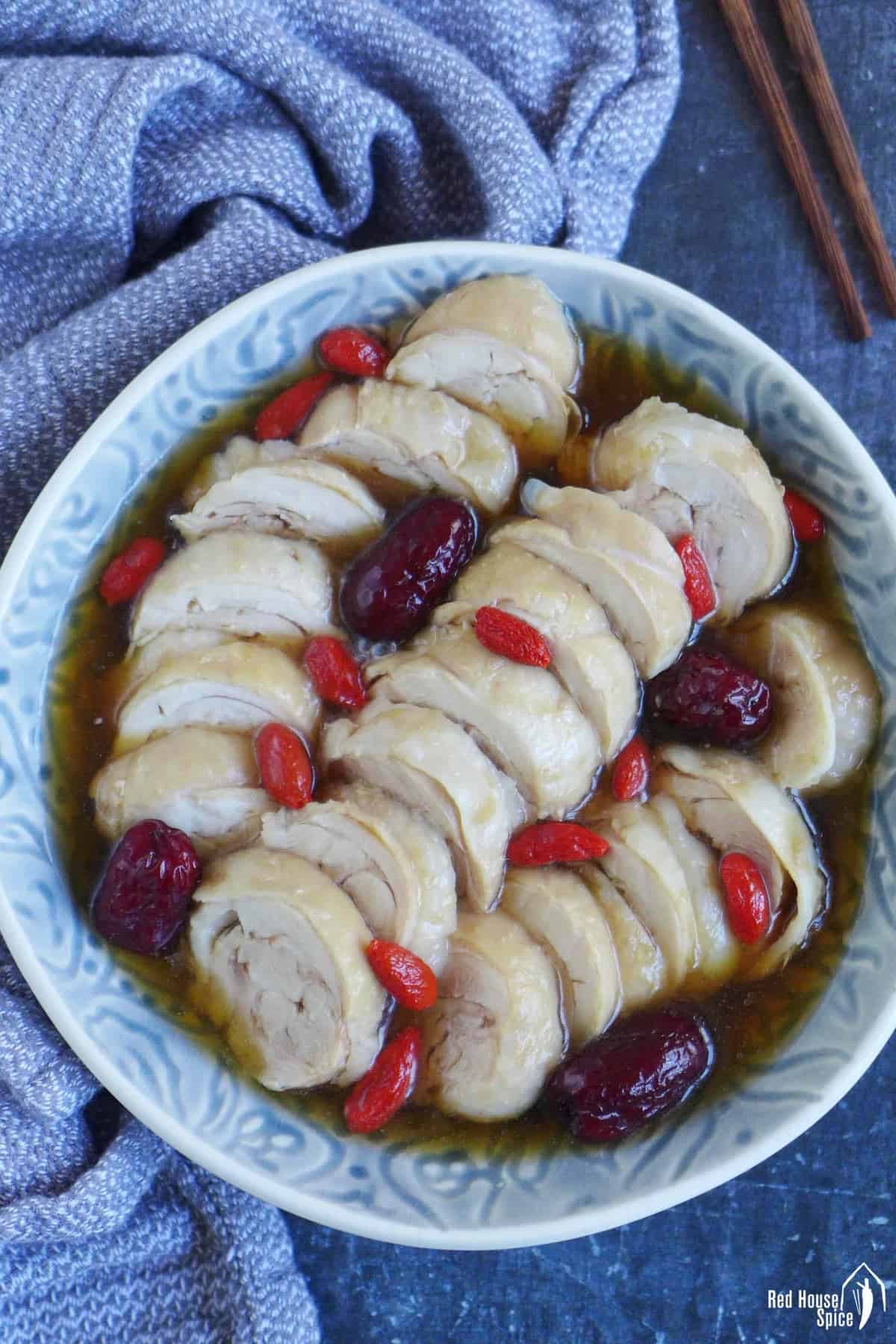
As the temperature rises and I fancy something cooling for dinner, Chinese drunken chicken (Zui Ji, 醉鸡) came to mind. It’s one of the dishes I always order when visiting the Jiangnan region of China where this delicacy was invented.
Essentially, it’s poached chicken soaked in a brine made of chicken stock and Shaoxing wine, a unique condiment widely used in Chinese cuisine. It’s loved for its tender texture, unique aroma and refreshing, umami taste. Although a classic that frequently appears at lavish feasts, it’s surprisingly easy to make at home. Totally novice friendly!
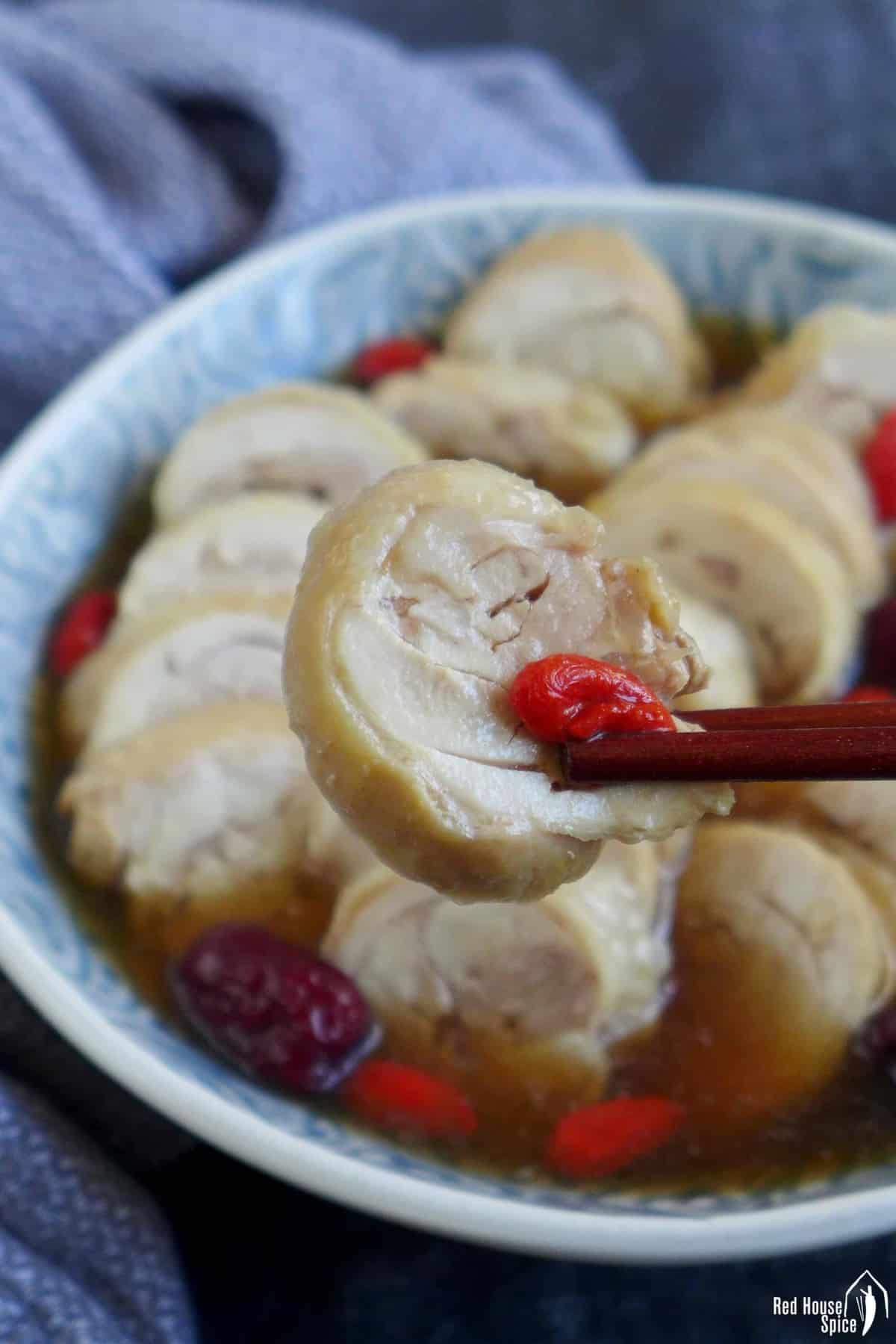
Ingredients
- Chicken legs
- Shaoxing rice wine
- Ginger and scallions
- salt and sugar
- Red dates & goji berries (optional)
It’s a very simple list, right? Here are a few tips that you might find helpful:
Chicken legs: For today’s drunken chicken recipe, I choose to debone chicken legs then form the meat into rolls. You may use other cuts of chicken, such as pieces of breast, thighs or wings. Alter the cooking time accordingly.
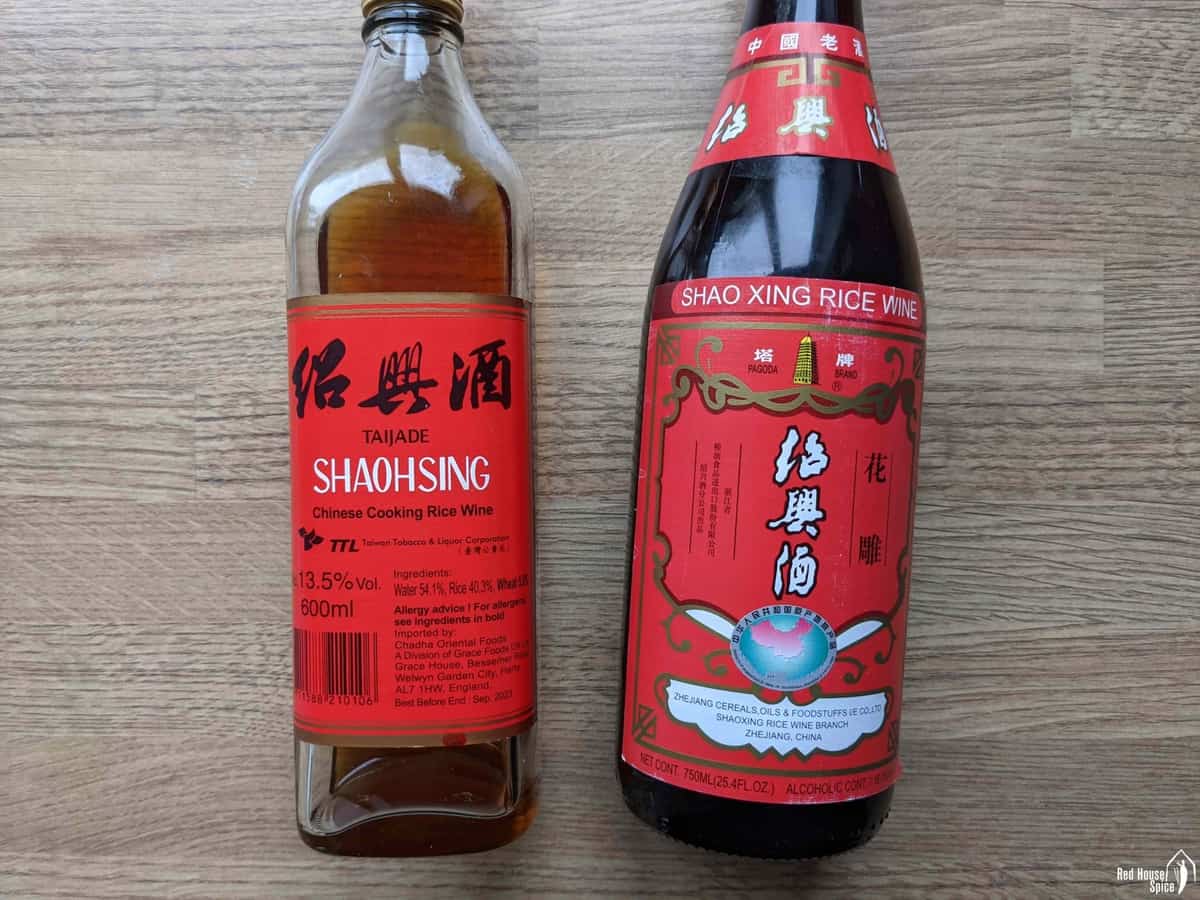
Shaoxing wine (绍兴酒), or Shaoxing rice wine (sometimes spelt Shaohsing), is the most reputable variety of Chinese yellow wine (Huang Jiu/黄酒) that’s made of rice. It’s both an alcoholic beverage and a popular cooking condiment. Since it’s the key seasoning for drunken chicken, I recommend you use Hua Diao Wine (花雕酒), a supreme version of Shaoxing wine, for its more complex aroma.
Red dates (aka jujube) and goji berries (aka wolfberries) are often paired with Chinese rice wine (based on beliefs in Chinese traditional medicine). I add them to today’s dish for their colour and hint of sweetness. But they’re entirely optional.
Step 1: Make chicken rolls
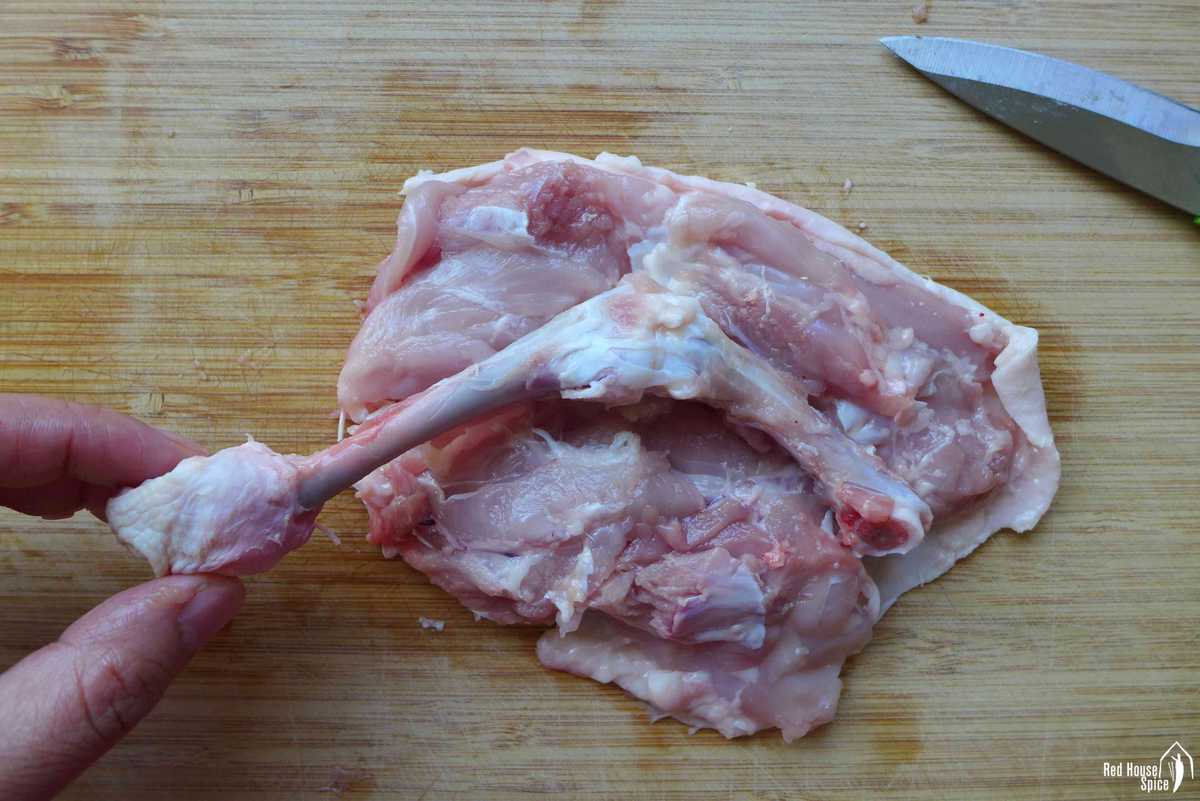
Firstly, debone the chicken legs with a paring knife. If you don’t know how to do it, ask your butcher for help or watch this video on how to debone a chicken leg.
Place the chicken flat on the chopping board with the skin side down. Score the meat randomly (without cutting through) to even the thickness.
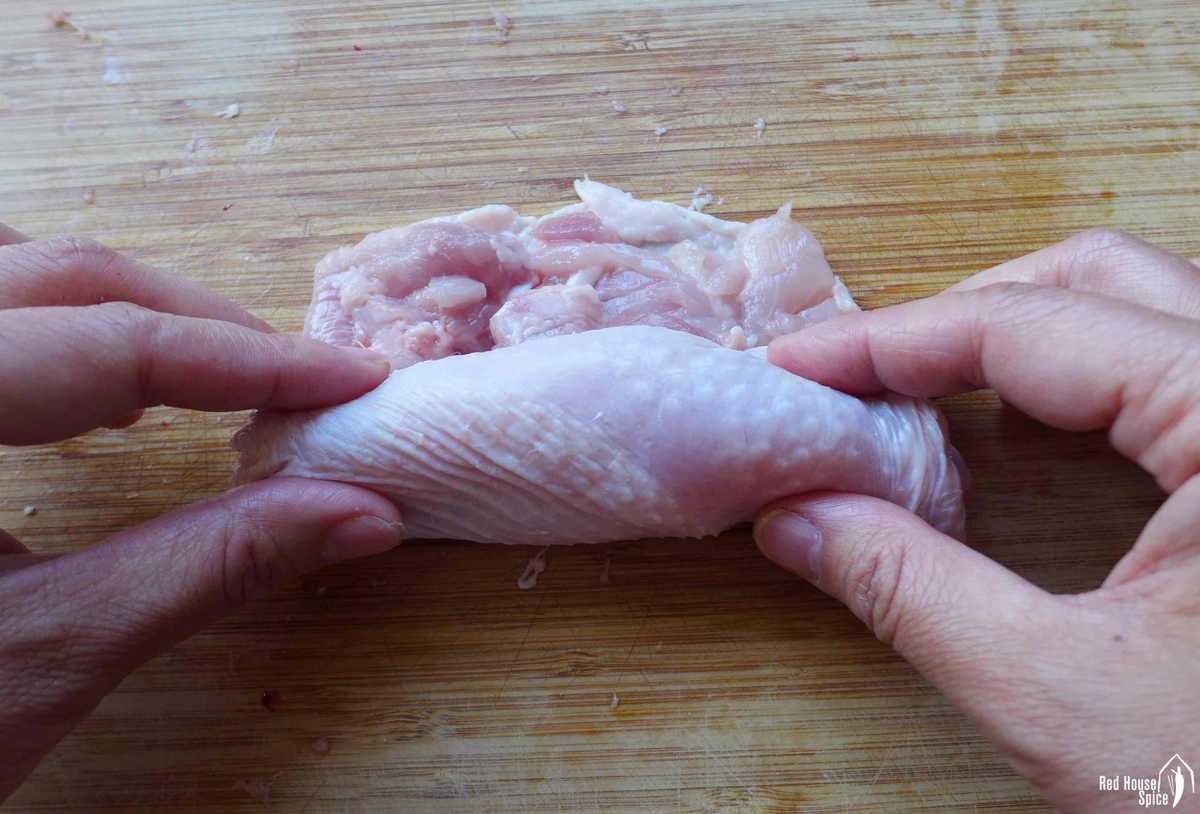
Roll the meat into a cylinder (as tightly as possible). I use kitchen twine/string to secure the shape. You may also wrap the chicken with kitchen foil/aluminium foil to achieve the same goal.
Step 2: Cook the chicken
This step involves a special cooking procedure, simmer-steep-cool, that’s applied to many Chinese cold chicken dishes, such as Sichuan Mouth-watering Chicken. It prevents overcooking and ensures a firm but tender texture.
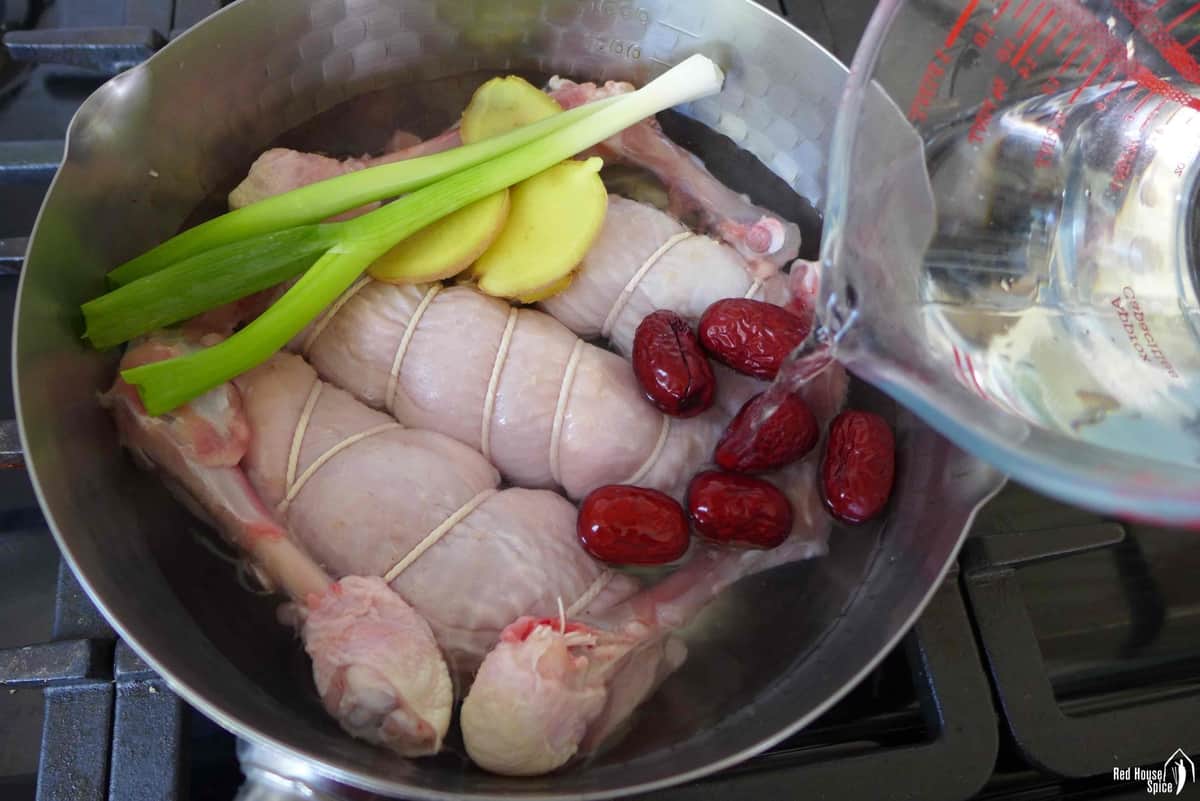
Put the chicken rolls and the bones into a small pot. Add scallions, sliced ginger and water just enough to cover the meat.
Bring the water to a full boil then turn the heat down to a bare simmer. Cover with a lid then leave to cook for 10 mins. Then remove the pot from the burner. Let the chicken sit in the stock for a further 10 mins (keep the lid on). During this steeping time, the remaining heat from the stock will cook through the meat.
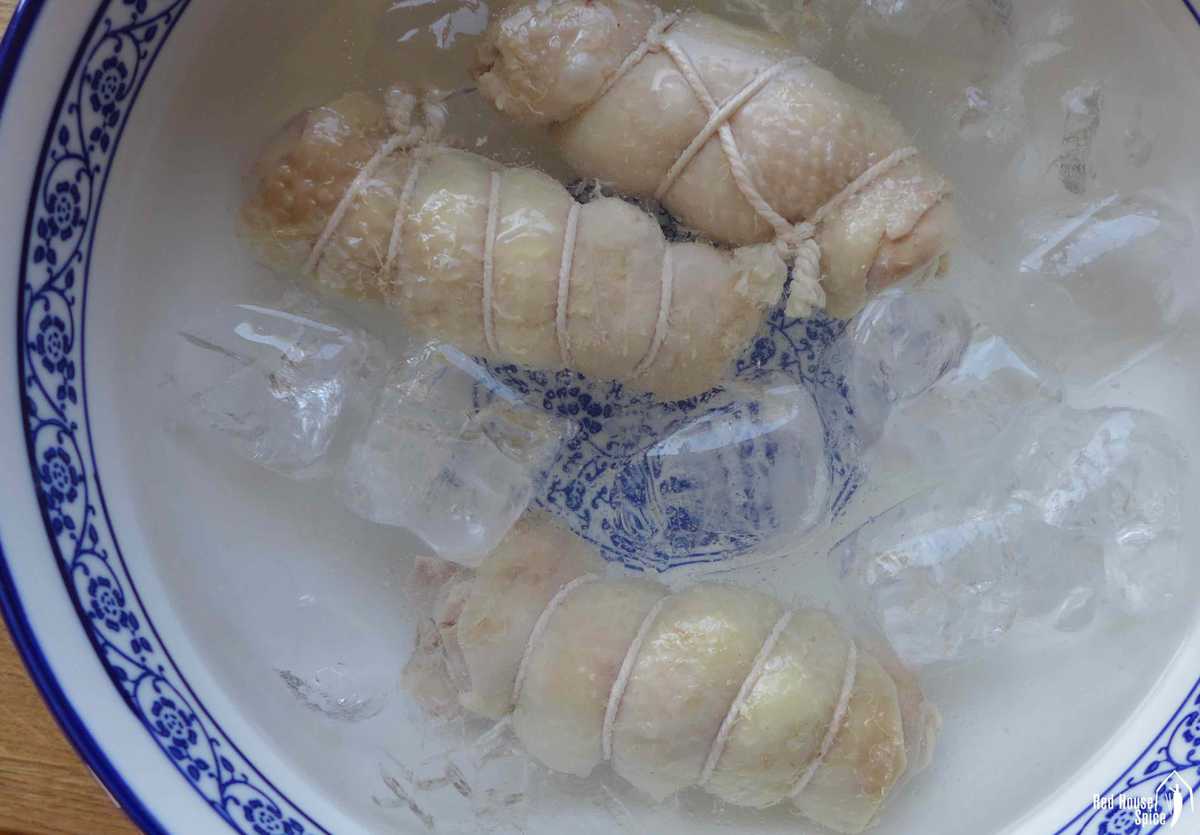
While waiting, prepare a large bowl of cold water. Add ice cubes if available. As soon as the time is up, put the chicken rolls straight into the chilled water. Leave to cool for 10 mins.
🛎Tip: The chicken legs I used weighed about 225g (½ lb) each. If your ones are bigger, you may need to increase the steeping time a little. If unsure, check the doneness by inserting a skewer. If there isn’t much resistance and the juice coming out appears clear, the chicken roll is fully cooked.
Step 3: Prepare the brine
Mix the brine in a non-reactive container (glass or ceramic). Ideally, it should be just big enough to hold the chicken rolls. This way you wouldn’t need too much brine to fully cover the meat.
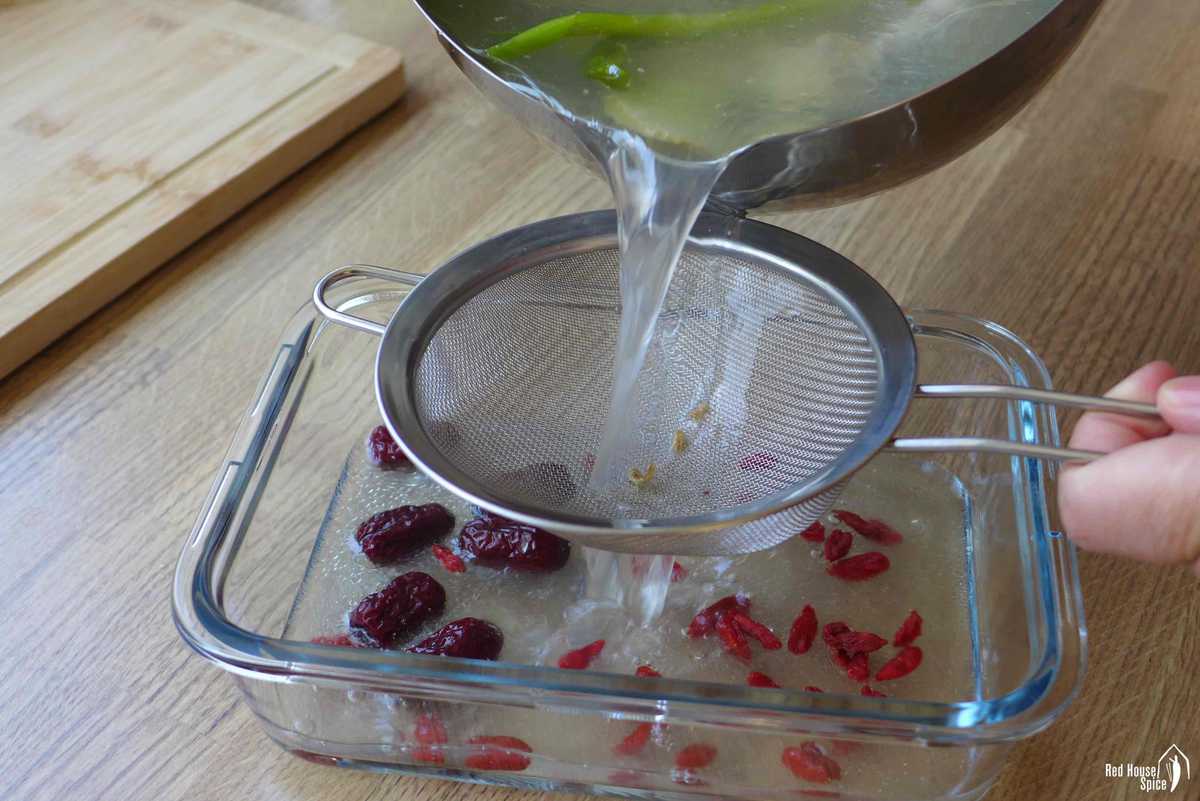
Through a fine sieve, pour about 250ml/1 cup of the chicken stock made in the previous step into the container. Add the cooked red date, 2 teaspoon of salt, 1 teaspoon of sugar, 1 tablespoon of goji berries and 180ml (¾ cup) of Shaoxing rice wine. Stir to help dissolve the salt and sugar.
🛎 Tip: If you wish to reduce the alcoholic taste of the dish, you may either alter the stock wine ratio (more stock and less wine) or boil the brine mixture for 2 mins.
Step 4: soak the chicken

Once the brine cools to room temperature, put in the chilled chicken rolls (remove the kitchen foil if it’s used). The liquid should be enough to fully immerse the meat. If not, top up with a little more chicken stock.
Cover the container with a lid then store in the fridge for at least 12 hours. You should be able to have it refrigerated for up to 3 days.
Serve the dish
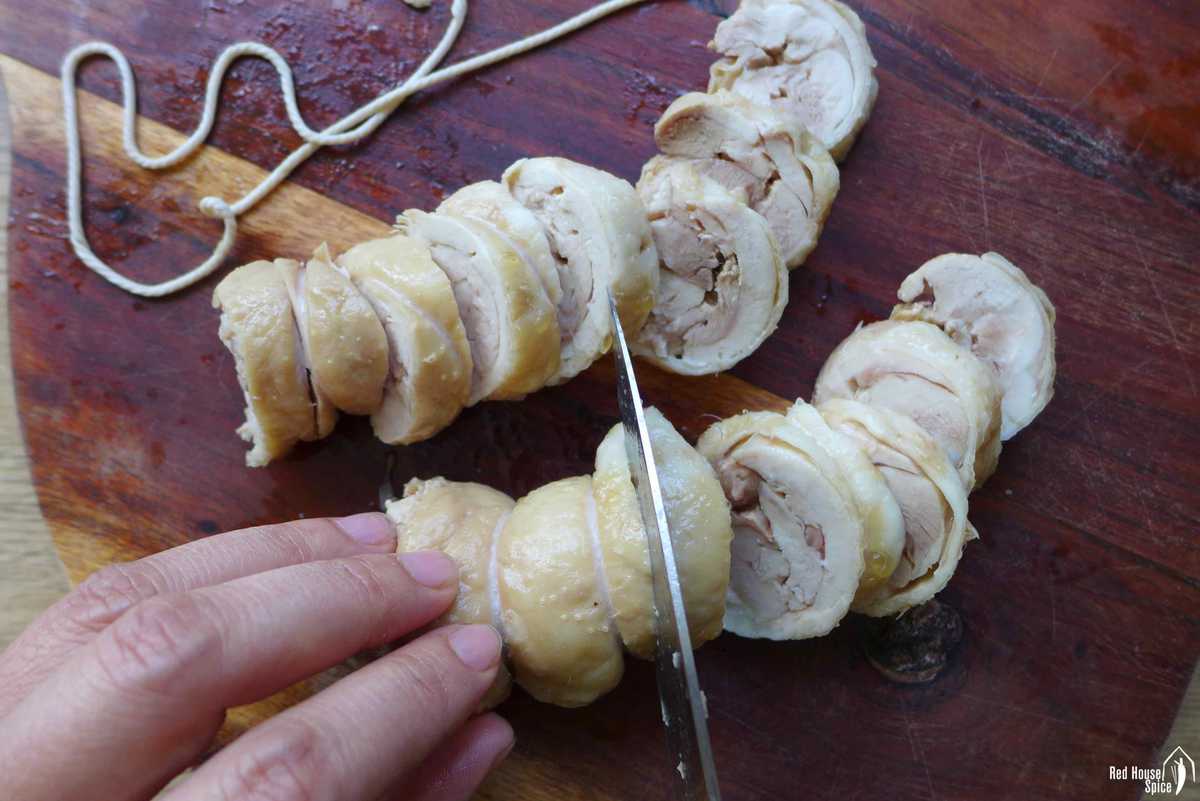
Take the chicken rolls out of the container. Remove the strings. Cut each one into 1½ cm (½ inch) thick discs. Place them into a serving bowl. Add some brine and garnish with red dates and goji berries.
Drunken chicken is usually served chilled, along with other savoury dishes, with a bowl of steamed rice.
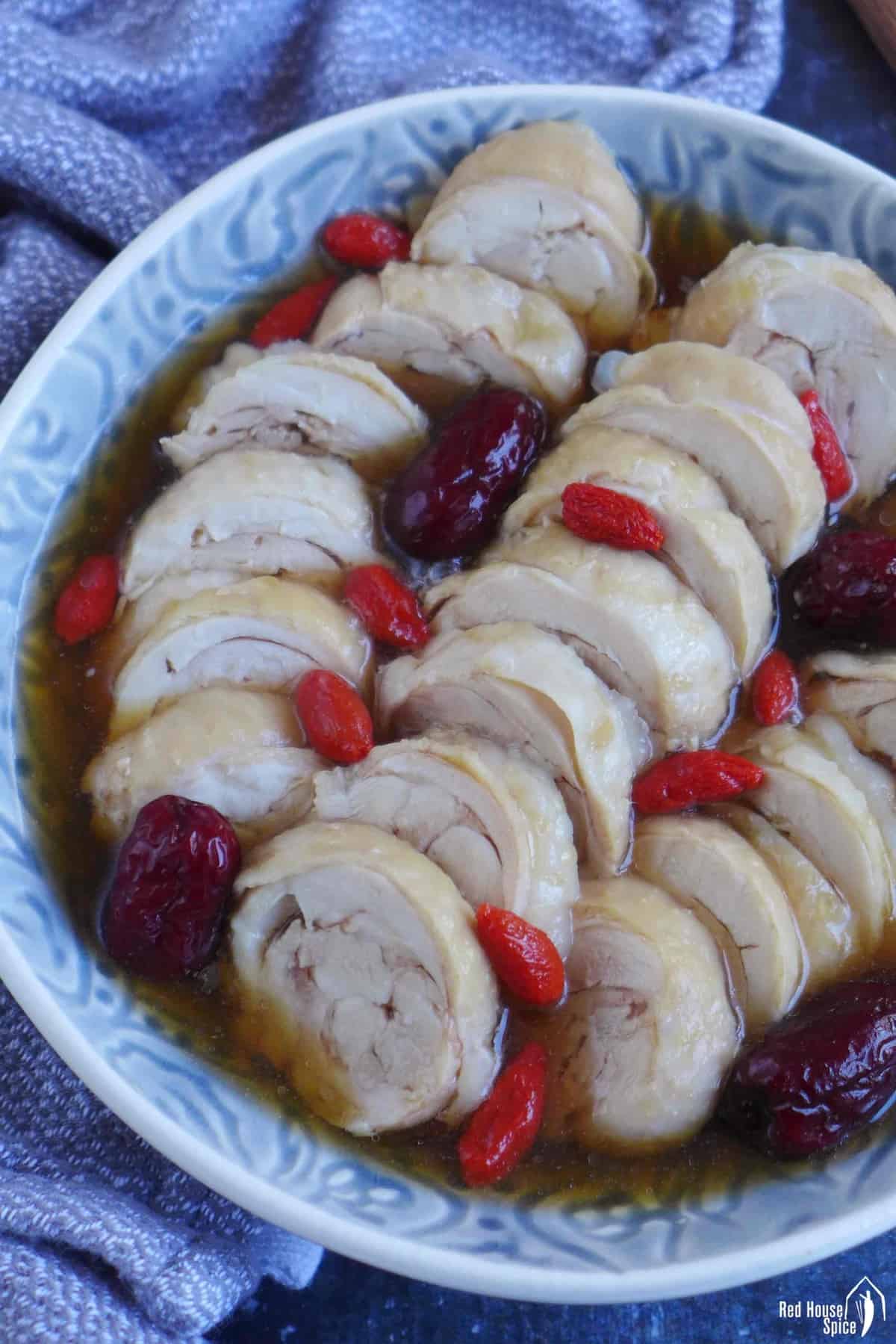
More delicious chicken dishes
Looking for more inspiration to cook chicken? Here are some recipes you may like:
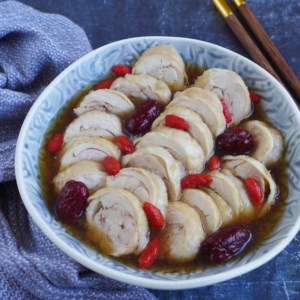
Drunken Chicken (Zui Ji, 醉鸡)
Ingredients
For the chicken
- 3 free-range chicken legs - about 680g/1.5 lb (see note 1)
- 5 slices ginger
- 2 stalks scallions
- 6 dried red dates/jujube - optional
For the brine
- 2 teaspoon salt
- 1 teaspoon sugar
- 1 tablespoon goji berries/wolfberries - optional
- 180 ml Shaoxing rice wine, preferably Hua Diao/花雕 variety - about ¾ cup
Instructions
Make chicken rolls
- Remove the bones of the chicken legs. Lay one piece flat with the skin side down. Roughly score the meat to make it more even in thickness (do not cut through).
- Tightly roll the meat into a cylinder. Use kitchen twine to secure (You may also wrap it with kitchen foil/aluminium foil).
Cook the chicken
- Put the chicken rolls, along with the bones, into a small pot (ideally just big enough to hold the rolls in a single layer). Add ginger, scallions and red dates. Pour in water enough to cover the meat.
- Bring it to a full boil then turn the heat to the lowest. Leave to simmer with a lid on for 10 mins. Then remove the pot from the cooker. Leave to steep (still covered) for a further 10 mins.
- Check the doneness by inserting a skewer into a chicken roll. They’re cooked if there isn’t much resistance and the juice coming out is clear (if using a kitchen thermometer, the inner part of the chicken should be above 165°F/74°C).
- Put the chicken rolls into a big bowl of cold water (ideally with ice cubes). Leave to cool for 10 mins.
Prepare the brine
- While waiting for the chicken to cool. Pour about 250ml (1 cup) of the chicken stock made from last step, through a sieve, into a non-reactive container. Add the cooked red dates, salt, sugar, rice wine and goji berries (see note 2). Leave to cool.
Soak the chicken
- Once the brine cools down to room temperature, put in the chilled chicken rolls (They should be fully immersed. Top up with more stock if necessary).
- Refrigerate for at least 12 hours. Slice the rolls and put into a serving bowl. Pour in some brine and garnish with red dates and goji berries.
NOTES
- You may use other cuts of chicken, such as pieces of breast, thighs or wings. Alter the cooking time accordingly.
- If you wish to reduce the alcoholic taste of the dish, you may either alter the stock wine ratio (more stock and less wine) or boil the brine mixture for 2 mins.
NUTRITION
NUTRITION DISCLOSURE: Nutritional information on this website is provided as a courtesy to readers. It should be considered estimates. Please use your own brand nutritional values or your preferred nutrition calculator to double check against our estimates.





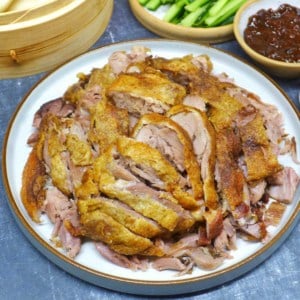

How can I prevent my brine from turning into jelly the next day?
If your brine turns into jelly (aspic), that’s probably because your chicken stock is too “concentrated”. You can try using more water to cook the chicken the next time.
Didn’t have the berries but it was still amazing. Just like I’ve had in Shanghai, except boneless for my wife. haha
Yes, it’s usually served with bones in restaurants in China. But boneless ones are so much easier to eat. Glad you’ve enjoyed it!
I have made this from a different recipe before. I want people to note that the quality of the shiaoxing is very important. The better the quality, the better the results. I first used an inexpensive brand that made it bitter tasting. This is a good recipe and I will definitely make this again.
I agree with you Alexandra! The quality of the Shaoxing wine does matter.